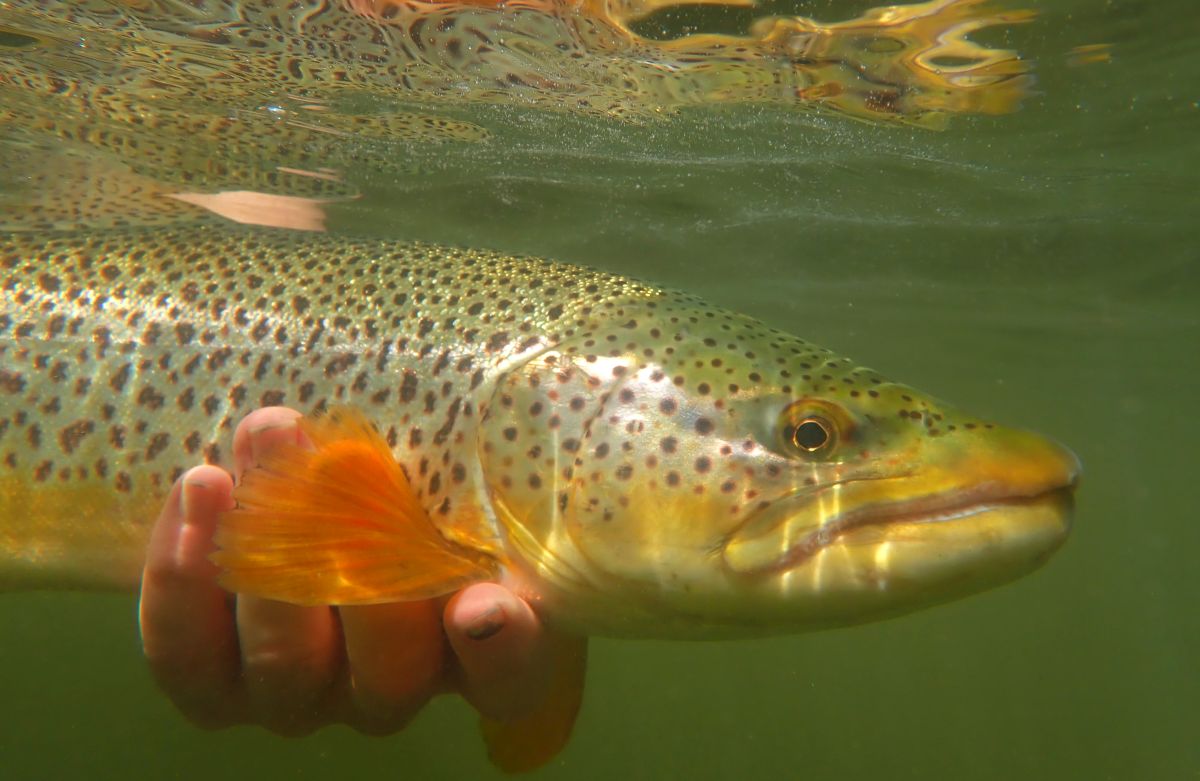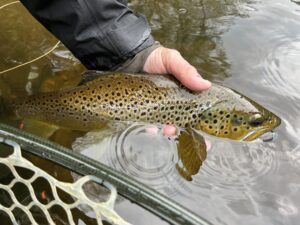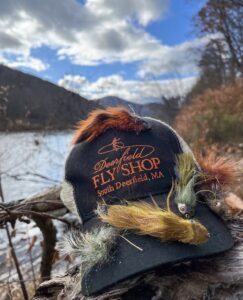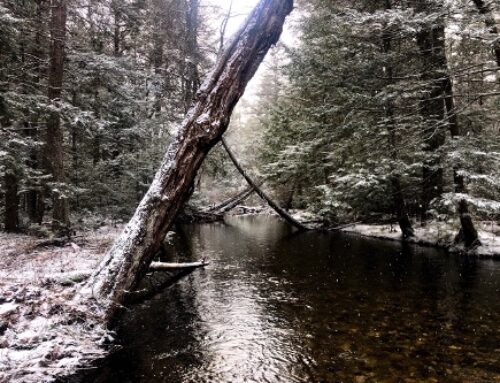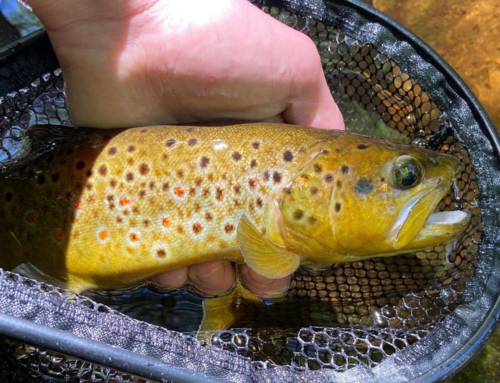By Brian Comfort
As the trees turn and set fire to the landscape, my focus returns to trout and, inevitably, how to fool them with streamers. While trout eat streamers year round, the fall seems to bring out a little extra gusto in their appetite for big meaty offerings. Taking advantage of this can lead to some of the most exciting fishing of the year and opportunities to catch some of the biggest fish in the river.
When the days get shorter and the water temperatures start to plummet, trout sense the advent of leaner times. For brown and brook trout, it also stirs the primal urge to procreate. Spawning season exacts a heavy physical toll on trout, and, thus, they need adequate energy reserves to survive it. It also brings out their competitiveness and territoriality. They spar with one another and defend their turf, aggressively chasing away anything that dares to enter their domain, including your streamer.
For me, successful streamer fishing is a mindset as much as anything else. When you are targeting the bigger fish in the system, it is a high risk, high reward situation. There are only so many of them, and they didn’t get big because they are stupid. You can go through long dry spells with a lot of casting and only a tired arm to show for it. But if you stick with it, and do it thoughtfully, you may just catch the biggest trout of your life, which seems like a reasonable trade off to me.
Below are five tips that can help you get into the right frame of mind. After that, I will add some more practical considerations, including gear recommendations.
Fish every cast like it is going to catch a fish. I lifted this from Boston area legend, the late great Jack Gartside and his book Striper Strategies. This works on several levels. First, it means to cast thoughtfully. Choose areas where you think feeding fish will be, methodically work your way down choice runs, make that cast to that spot under an overhanging tree where you just know a fish lies in wait until you hit it just right. It also means have confidence in each cast. Swim that fly back to you like a fish is going to grab it at any moment. Strip with purpose and guide the fly in and around fishy looking rocks and logs. Be ready and focused for the eat. This probably sounds self-evident, but it is easy for your mind to drift when streamer fishing and get into a sort of mindless cast and retrieve repetition, especially when you go through slow times, which always happen when streamer fishing. But if you are confident that you fished a stretch well, offering the fly to spots where you are pretty certain there are fish, then you can confidently decide to change flies or retrieves or fish a different area.
Mix it up. I like to carry a wide assortment of streamers in various colors (olive, white, brown, black, tan, gold, chartreuse, yellow, purple, orange), of various sizes (from one to five or six inches long for trout) and of different actions (floating, weighted jig style, neutrally buoyant, single hook, articulated). While it can be important to match food sources (the Deerfield has sculpins, dace and crayfish in abundance), trout also attack streamers out of territoriality and instinct. I do not generally get too caught up in matching a hatch but will have flies that are suggestive of certain prey and others that are just plain provocative. I switch colors, sizes and actions regularly until I key in on what’s working.
There is no wrong way to retrieve a steamer. Fast, slow, steady, erratic, on the surface, just below the surface, near the bottom, lots of rod tip movement, no rod tip movement, swinging, dead drift, upstream, downstream, across stream. All presentations and retrieves will have their moments but at any given moment, one retrieve will likely be more effective than another. Often very slow retrieves with occasional twitches can be deadly or nice steady swings in the current will elicit strikes, but sometimes smoking the fly back to you works better or using a jerk-strip retrieve on a fly cast upstream will entice the bite. Embrace trial and error. Mix it up until the fish tell you how they want to see the fly. And know that it can change over the course of the day so if things get slow, switch it up again.
Cover ground. Not all the fish in the river are ready to eat a streamer at any moment, but often many of the biggest and most aggressive are. I like to move through areas fairly quickly. Generally, a couple good casts with a couple different retrieves and then I move down- or up-stream or to another spot entirely. If it’s a particularly juicy run, I will take a few more casts with a few different retrieve styles and maybe switch flies. But I don’t spend too long on any stretch. Better to cover more water and find those fish that are hungry or aggressive or, better yet, both. If I struck out in an area that I know has decent numbers of fish, I may come back later after fishing a different stretch of river with a whole different set up—significantly smaller or larger fly, switch from floating to sinking line, switch from downstream to upstream presentations–and see if that changes my luck.
Sharpen your hooks. The best anglers I know are regularly checking their hooks and re-sharpening them if needed. While sharp hooks will definitely help you stick and land more fish, I think this also speaks to an attention to detail that successful anglers have. If you take the moment to sharpen your hook you likely take a moment to double check your knots, spend an extra few seconds looking for that fly that will move the way you want it to move, think about the subtle differences in the water structure and where fish might be holding given current conditions, take that extra cast until you know your fly swam through that current seam in just the way you wanted it to. There are thousands of small details in fly fishing. Any single one of them is not likely to make or break a fishing outing, but when you consistently stack as many small details in your favor as you can, you will find more success.
Rods. For me, the ideal size rod for trout streamer fishing is a six weight. You should be able to cast larger and heavier streamers with a six weight yet you can still retain some delicacy with smaller streamers for low water conditions. I prefer a faster action rod as it helps in casting bigger, more air resistant flies. But the best rod for any trout fishing is the one you have. If that is a four or five weight you can still fish streamers but you will be limited to generally smaller, lightly weighted streamers. These can work, but there are times when bigger or heavier streamers may work better so that’s why I think the six is the most versatile set up (it also handles sink tip lines better).
Lines and Leaders. As for fly lines, here is where it can get fun. Your standard weight forward floating line works great, especially in lower water conditions. If you need to get deep, you can lengthen your leader and add weight, either in the fly directly or with split shot. You can also mend most effectively with a floating line. Mending does so many things for your presentation: change speed, change depth, change direction. All these can trigger a strike, so mess around with your mending.
Sinking lines will also have their moments. I avoid full sink lines because they do not mend well. Instead, I use sink tips. If I need to get very deep, I will opt for a long sink tip of 25 feet. For lesser depths, I will opt for a much shorter sink tip of 5 to 15 feet or use an intermediate line. You can use those Versileader sink tips if you don’t want to buy, or carry, multiple fly lines. They do add a hitch to the cast and another disruptive point going through the guides, but they will give you options.
One counterintuitive note about getting flies deep: If I need to get a fly deep quickly when fishing faster pocket water, I will opt for a floating line and a heavy fly on a long leader. The heavy fly should drop quicker on the thinner leader than it will with the thicker sinking fly line that is more affected by the moving water.
While your line choice can affect the depth of your presentation, it also affects the action of your fly. For optimal jigging action, I like a fly weighted at its head fished on a long leader and floating line. For reverse jigging action, I go with a deerhair head fly on a sink tip line—this will allow the line to sink below the fly, jerking it down every time you strip and allowing it to flutter upward every pause, much like an injured bait fish.
As far as leaders go, I will use a 7.5 or 9 foot tapered 1X or 2X leader on a floating line. I might go down to 3X in really low water with a small streamer. On an intermediate, I will usually opt for a straight five or six foot section of 1X or 2X. For sink tips, three or four feet of 1X or 2X is ample.
Water Levels. On the Deerfield, you will encounter two distinct conditions regularly: higher flows linked to the dam release and the lower water of the non-release periods. I like fishing both but prepare for each a bit differently. Generally at low water I am using a floating or intermediate line and as a rule opt for smaller flies up to four inches or so. That said, I will still fish deeper holes with sink tips and/or bigger flies. At high water, I will fish any line and tend to gravitate toward flies in the three to five inch range.
Flies. I touched on this above in general terms, but I know many folks like a little more specificity so here are a few specific patterns. For smaller flies, wooly buggers, zonkers and muddler minnows are standards and hard to beat. Medium size flies would include Strolis Ice Picks, Mini Avengers and Silly Rabbits. Bunny Sculpins, Bank Robbers, Heisenbergs, and Strolis Headbangers and Hog Snares are good jig style flies. For reverse-jigged flies with deer hair head, you can’t go wrong with Mini Drunk and Disorderlies or Strolis Alteregos.
Now is a great time to get out there and develop your streamer game. Who knows, you just might latch onto something big. As always, come into the shop with any questions. We are actively seeking contributors for this blog. Please contact brian@deerfieldflyshop.com if you have any interest in writing a post or have an idea for a post.


